Term 1 Project: Abstract Line Skulls
Posted: November 22, 2013 Filed under: Subject Leave a commentHaving messed around with a bit of colour in my work, I ended up returning to black and white. I wanted to see what abstract skulls I could create using simple lines and shapes.
- Line definition
- Negative
- 0.1 pen
- 0.1 pen
- 0.1 pen
- Watercolour
- Coloured pencil, complimentary colours
- 0.1 pen
- 0.1 pen
- 0.1 pen
I will experiment more with this type of drawing; I enjoyed trying to see angular, simplified shapes in a fairly complex object. I shall try different angles, different skulls, different shapes etc.
Term 1 Project: Abstract Colour Skulls
Posted: November 18, 2013 Filed under: Subject Leave a commentAfter my tutorial with James Green and looking at Picasso’s post WWII skulls, I started trying to create my own abstract skulls. I don’t produce abstract work as a rule. I find it very difficult letting go of realism and detail. I also don’t often work in colour, as I tend to prefer greyscale and black and white. As I rarely work in either of these ways, I decided to combine the two.

I began attempting abstract colour skulls simply using oil pastel. I thought the colours would be vibrant and rich. However, I didn’t enjoy using them for this piece. Actually, I didn’t feel this piece went well at all. ‘Abstract Blue Bean Skull’ wasn’t pristine and sharp enough – the edges blurred, the colours smudged with the black and I was overall unhappy with the outcome.
Instead, I tried using chalk pastels and working from my imagination. I purposely picked colours that don’t relate to the skull (especially not the ‘primitive’) and that I wouldn’t normally use. Pink, for example, I can never imagine using as a dominant colour in a piece.
Again, though, I wasn’t really very impressed with the outcome. The pink skull, especially, lost the abstract feel and turned more Impressionist.
Instead, I decided to try using MS Paint. I’ve enjoyed using Paint in the past, and thought this would be a simple way to persuade myself into abstraction and colour. MS Paint would limit the shapes I could create, forcing me to simplify the skull, but also allowing for clean edges and filling of shapes quickly to see what colours worked where.
Term 1 Project: Artist Research – Picasso Skulls
Posted: November 18, 2013 Filed under: Subject Leave a commentAfter a tutorial with James Green, who suggested I perhaps try adding some abstraction and colour into my work, I have been looking at the abstract skulls of Picasso.
Whilst also reflecting on death and decay, my work is also about the primitive man, to whom simplistic and symbolic shapes and patterns would have been very important. Picasso’s abstract skulls are very simplistic, yet represent the skull very obviously. Early man and tribal groups would also have looked for shapes and representations in nature, and colour would be very important for rituals and spirituality. I plan to also look more at tribal masks – can I take any ideas about representing the skull in a more simplified manner from such masks?
Pablo Picasso – Black Jug and Skull
This macabre black and white piece (made in 1946) is considered to be associated with suffering and death experienced during World War 2.
Pablo Picasso – ‘Skull and Pitcher’
Pablo Picasso – Skull, Urchins and Lamp on a Table
This piece obviously relates to the Dutch Vanitas paintings – the skull juxtaposed with the lamp and urchins. I rather like the shading on the skull, whilst the majority of the painting remains very flat and 2D. There is also onoly the slightest hint of the colour blue, adding a somber quality to the painting.
Term 1 Project: Artist Research – Vanitas Painting
Posted: November 18, 2013 Filed under: Subject Leave a commentDefinition: (noun) – A vanitas painting was a particular type of still life immensely popular in the Netherlands. A vanitas painting, while possibly containing lovely objects, always included some reference to man’s mortality – most often a human skull (with or without other bones), but also by way of burning candles, soap bubbles or decaying flowers. It was meant not only to be a work of art, but also to carry an important moral message: Trivial pleasures of life are abruptly and permanently wiped out by death.
(Taken from http://arthistory.about.com/od/glossary/g/v_vanitas.htm)
Pieter Claesz was a Dutch ‘Golden Age’ still life painter. His pieces often contain symbolic meanings; such as the skull as a reminder of human mortality.
Pieter Claesz, ‘Vanitas – Still Life’
Pieter Claesz – ‘Still Life with a Skull and a Writing Quill’
In this particular piece, all the articles in the painting suggest that worldly efforts and possessions are ultimately meaningless; the skull representing man’s mortality, the expired lamp. Many paintings often also include representations of decay such as burning candles, flowers or fruit. The juxtaposition of skulls with such items reinforce and highlight the idea of death and decay.
I am considering using the Vanitas idea and incorporating some other objects into my pieces; a study of candles or decaying fruit may add more depth of feeling to my work, as it is all about the death and decay of man, but also evolution and continuing life cycles.
Term 1 Project: Plastic Model Skull
Posted: November 10, 2013 Filed under: Subject Leave a commentWhilst browsing charity shops on Albany road just before Halloween, I came across a plastic model of a skull. It looks as if it’s part of a ‘build your own skull’ set, as the eyes, top of the skull and everything besides the teeth was missing. The teeth also needed to be detached from the plastic and inserted into the ready made holes in the jaw.
I’m still not entirely sure what I’m planning to do with this skull. I’m planning to paint it using Acrylic, and perhaps remove some of the teeth. The jaw is hinged too, so I may be able to use this in some way. I may rub dirt or mud into the shiny white plastic to make it look more used and rustic. I could also bury it in the garden and photograph the outcomes of being left there for a few weeks, though I suspect this will have very little to no effect on the plastic.
I decided to add some shading to the skull using brown acrylic.
I’m not sure I want to take this particular skull any further; the plastic quality and model ‘perfection’ is not really relevant to the rest of my project.
Term 1 Project: Bone Experiments
Posted: November 10, 2013 Filed under: Subject Leave a commentI had found a few pieces of bone at the time I created the ‘Bone Skull’, but I hadn’t been sure what to do with them.
I had also found another piece of bone that instantly made me think of an eye socket. I have just started sketching the shape of the bone, and am thinking of including the actual bone in a painting – perhaps cutting through canvas so the bone is integrated into the piece as an eye socket.
I then turned this bone to the side, which appeared to me as half of a Venetian mask. This related back very well to my Venetian skull mask. I decided to manipulate the photo quickly on MS Paint just to see if my idea worked.
After flipping the picture, cutting it out and positioning it more centrally, I thought it seemed very Venetian mask-like indeed. Perhaps I could make a cast copy of the bone, and then use this identical shaped bone-like material to work with and create a real version of this bone mask.
Unfortunately, I have discovered that the bone (being jagged and rounded) does not lend itself well to prints and stamps. Rubbings were also not very successful, so I have been unable to create shapes from the bone with which to work. Instead, I am continuing to sketch the bone and integrate it into a piece – either drawing or painting.
Term 1 Project: Ash Painting
Posted: November 10, 2013 Filed under: Subject Leave a commentAfter burning the papier mache rocks, I collected the ash and remnants of rocks and then mixed some of the ashes in with a spot of water. I painted on normal paper, and some small canvases.
I also seemed to have created some home-made charcoal. I’m not sure if these were bits of ‘rock’ or left over matches. I decided to use this to draw some skulls.
I also did some quick skull sketches using the larger chunks of leftover burnt rock. I quite like the wispy, ephemeral quality that was produced.
I may try incorporating both ash and charcoal into a larger piece, or use a variety of smaller canvases to make up one big skull piece when put together.
Term 1 Project: Burning Skulls
Posted: November 4, 2013 Filed under: Subject Leave a commentI wanted to re-use the already re-used paper mache rock skulls. I like the idea of recycling old work into something new. I decided to burn the prior made skull rocks. I was really curious to see what would happen when they burned, and I plan to use the ashes from the burnt rocks to either draw or paint skulls. I also think this relates well to the skull; the idea of decay and death, but then that death providing and supporting new life.
I started trying to burn the rocks with matches. This proved a lot more difficult than I imagined, and the rocks wouldn’t catch alight. I only managed to singe the outer layers. The rocks were reminiscent of condensed paper logs for the fire, and burned very slowly.
After trying to get the rocks to catch alight by stuffing it with matches and still failing, I decided to use a blowtorch to get the rocks to burn. This was far more effective, but still was surprisingly difficult to burn the rocks.
I really liked how the rocks changed after burning; they were lighter, more fragile, and gained interesting textures from the melting tape and oil paint.
I have kept the burnt rocks and collected all the excess ash after the burning, and I am planning to use these to paint and draw; creating new skulls from the remains of the old.
I also had a different paper mache skull rock that I had created using a sponge as the inner core of the rock instead of scrunched up card or newspaper. I was very interested to see how the sponge would react to being burned.
The sponge burned very successfully (using a lighter). Partially because the sponge was exposed from cutting the rock to create the skull shape, and also because sponge seems to burn well. It was particularly intriguing how the sponge inside the rock burned, but the outer casing remained intact. The burning added a pleasing singed effect around the edge of the skull if viewed straight on, and also allowed a view through the skull from the side, where the burned innards and melting sponge is visible.
There was something very satisfying about burning a piece of work, and I’d be interested in doing this again in another context. The notion of creation and destruction, and also power and control would be really interesting to explore.
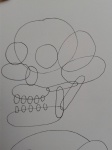
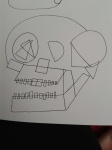


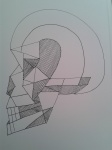
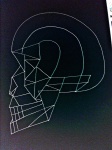
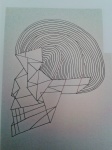
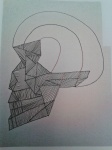
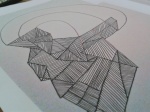
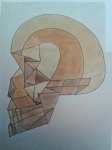
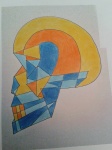
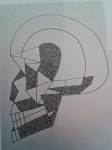
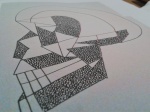
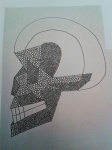







































Recent Comments